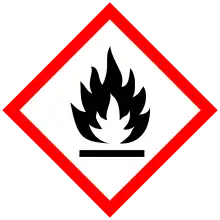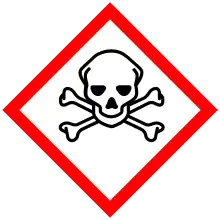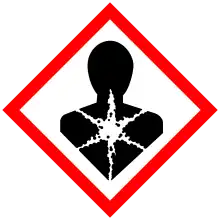 | |
| Names | |
|---|---|
| Preferred IUPAC name
Dibromo(fluoro)methane | |
| Other names
Dibromofluoromethane Fluorodibromomethane R-12B2 | |
| Identifiers | |
3D model (JSmol) |
|
| ChemSpider | |
| ECHA InfoCard | 100.148.872 |
PubChem CID |
|
| UNII | |
CompTox Dashboard (EPA) |
|
| |
| |
| Properties | |
| CHBr2F | |
| Molar mass | 191.83 g/mol |
| Appearance | Liquid |
| Density | 2.421 g/cm3 at 20 °C |
| Melting point | −78 °C (−108 °F; 195 K) |
| Boiling point | 64.9 °C (148.8 °F; 338.0 K) |
| Insoluble | |
| Hazards | |
| GHS labelling: | |
   | |
| Supplementary data page | |
| Dibromofluoromethane (data page) | |
Except where otherwise noted, data are given for materials in their standard state (at 25 °C [77 °F], 100 kPa).
Infobox references | |
Dibromofluoromethane is a mixed halomethane.[1] It is soluble in alcohol, acetone, benzene and chloroform. It is prepared from dibromomethane and antimony(III) fluoride.[2]
Applications
It can be used to prepare bromofluoromethane by reductive debromination with organotin hydride as tributyltin hydride.[3]
Regulations
Its ozone depletion potential (ODP) is 1.0 and it is included in list of Class I Ozone-Depleting Substances.
References
- ↑ "Dibromofluoromethane solution". Sigma Aldrich. sigmaaldrich.com. Retrieved 7 June 2017.
- ↑ Bernd Baasner (2014), [, p. 517, at Google Books Houben-Weyl Methods of Organic Chemistry Vol. E 10a, 4th Edition Supplement Organo-Fluorine Compounds - Fluorinating Agents and Their Application in Organic Synthesis], Georg Thieme Verlag, p. 517, ISBN 3-13-181544-2
{{citation}}: Check|url=value (help) - ↑ US patent 5189229A, Robinson, John M., "Debrominating dibromofluoromethane with tributyltin hydride", published 28 February 1989, issued 23 February 1993, assigned to Glaxo Group
This article is issued from Wikipedia. The text is licensed under Creative Commons - Attribution - Sharealike. Additional terms may apply for the media files.